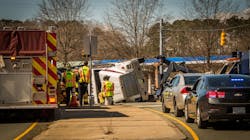Crash Responder Safety Week will be held from November 13-17. Every possible group or interest seems to have a day, a week, or a month dedicated to it. It's important for those who make their living on the highway and those, like me, who used to enforce our highway safety laws to recognize those who respond when things go wrong. And it's just as important to prevent things from getting worse.
Good truck fleet managers have undoubtedly trained their truck drivers on what to do when involved in an accident: Help direct other traffic away from the crash site using flares or emergency reflective triangles; call 911 and the company safety officer; and take photos and gather information.
Now imagine you are responsible not only for yourself but also for the care of those injured, the removal of disabled vehicles and debris, the safety of everyone else on that road, the prevention of secondary accidents, and the restoration of normal traffic flow. That is exactly what the police, highway patrol, fire departments, emergency medical teams, tow truck, and ambulance drivers must do, all as part of what is blandly named “traffic incident management,” or TIM.
What could go wrong? Ask any TIM member about the dangers inherent in the swirling, high-speed, unexpected environment surrounding a highway crash and they will likely name three groups of drivers:
- The Oblivious: The most dangerous driver in any environment, the distracted, daydreaming, unaware driver often reacts wildly when lane closures, flashing lights, and stalled traffic appear.
- The Gawkers: “Glad that’s not me,” thinks the driver who stares at an approaching crash scene and not at the brake lights looming immediately ahead.
- The Self-Important: Any delay in that driver’s appointed rounds is self-justification for speeding by a crash scene, suddenly changing lanes or even crossing a roadway median to access a nearby exit.
What could go right? Here’s what to teach your drivers to do when they see a crash scene ahead:
- Slow down and move over: Give the crash responders room to work. Use turn signals to indicate a lane change.
- Stop if necessary: Obey the directions from law enforcement at the scene.
- Turn on your blinking hazard lights: Warn others behind that there is a problem ahead.
- Watch for people on foot: Crash responders and the drivers involved may be checking vehicles or cleaning up debris and spills.
- Keep your eyes on the road and drive defensively: Remember, other vehicles near the crash scene may be driven by “The Oblivious,” “The Gawkers” or “The Self-Important.” Protect yourself.
Finally, protect the crash responders. A crash scene is a dangerous place to work, which is why they wear those reflective vests. However, what they do can save lives. They may even minimize the delay in travel. During Crash Responder Safety Week or at any time, it is true that superheroes wear reflective vests.
Steve Vaughn is senior vice president of field operations at PrePass Safety Alliance, the provider of PrePass weigh station bypass and electronic toll-payment and management services. Vaughn served nearly three decades with the California Highway Patrol and is a past president of the Commercial Vehicle Safety Alliance.
About the Author
Steve Vaughn
Senior Vice President of Field Operations
Steve Vaughn is senior vice president of field operations at PrePass Safety Alliance, the provider of PrePass weigh station bypass and electronic toll-payment and management services. Vaughn served nearly three decades with the California Highway Patrol and is a past president of the Commercial Vehicle Safety Alliance.
